Fifty years ago, a team of scientists crisscrossed Antarctica by plane, collecting radar images of the ice sheets. Now, a multicontinent effort to digitize and analyze that old data – with an assist from Hollywood – is providing invaluable insights about the form and flow of the southern continent’s ice sheets and their contributions to sea level rise as the world warms.
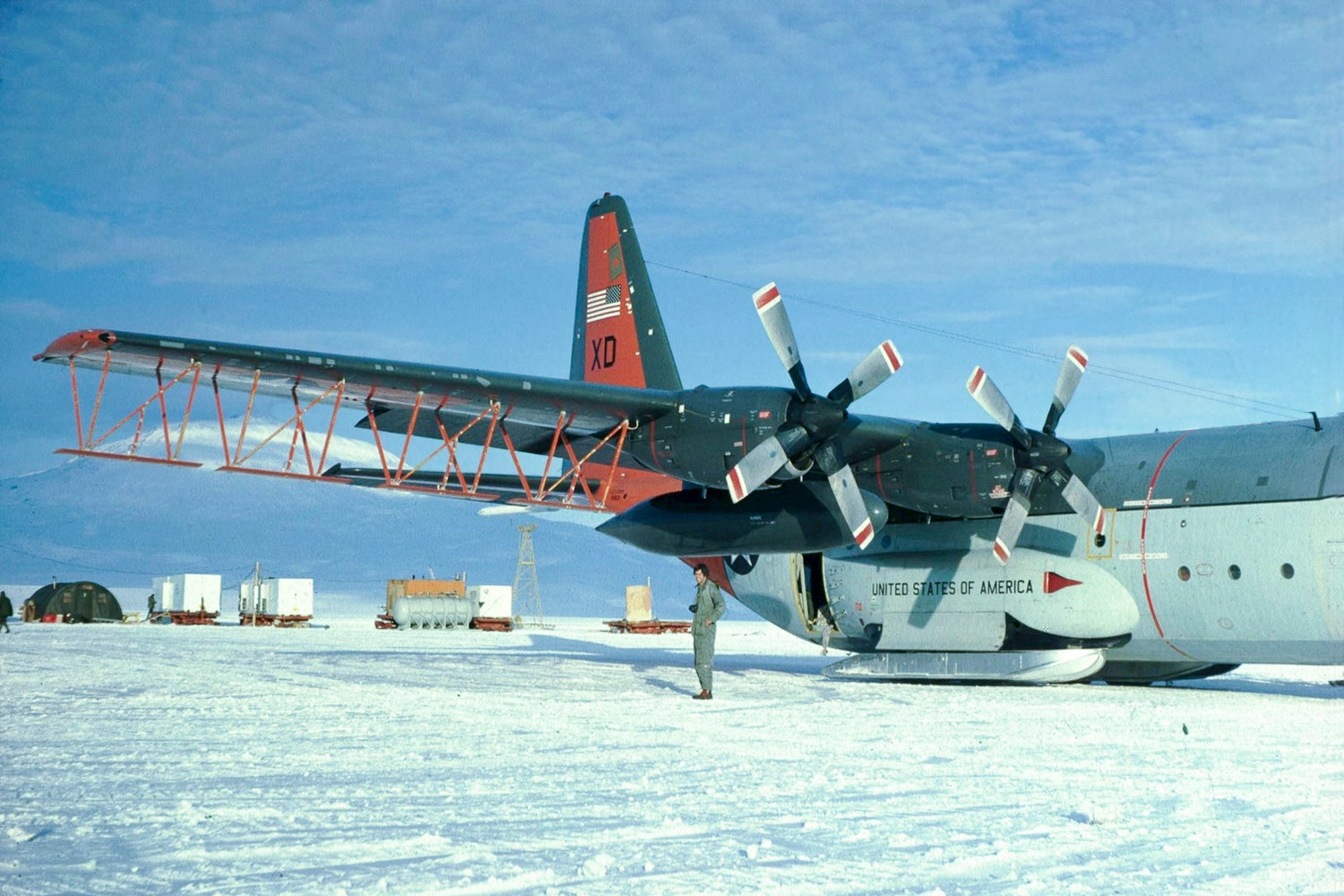
An American military C-130 cargo plane converted for Antarctic radar surveys at Williams Field in Antarctica’s McMurdo Sound. (Image credit: Courtesy David Drewry)
The project, a collaboration between Stanford University and the Scott Polar Research Institute (SPRI) at Cambridge University in the UK, was spearheaded by Stanford geophysicist Dustin “Dusty” Schroeder, who believed so strongly in the value of the data stored on the films that he risked a healthy chunk of his research budget on a state-of-the-art digital film scanner.
“It was a serious gamble, but it’s so rare that you have the opportunity to recover information from early observations that formed the foundations of your field and to make it accessible to the modern scientific community that we had to try,” says Schroeder, who is an assistant professor of geophysics at Stanford’s School of Earth, Energy & Environmental Sciences.
The nearly 1,000 rolls of 35mm and 8mm film had been gathered in the late 1960s and 1970s as part of an Antarctic survey conducted by an international consortium of American, British and Danish geoscientists.
The flights, made using a converted American military C-130 long-range aircraft, were geared toward exploring Antarctica, which was in many ways terra incognita at the time. “It was the final unexplored continent, and these scientists were trying to answer fundamental questions, like what was underneath all that ice,” Schroeder says.
Those historic radar measurements are still relevant today, Schroeder says, and could help improve scientific predictions about how climate change is affecting ice on the frozen continent — one of the biggest uncertainties in sea level rise predictions.
“The IPCC [Intergovernmental Panel on Climate Change] is working hard to make climate change predictions extending 20, 30, 50 years into the future,” Schroeder says. “With these old records, we know what Antarctica looked like 40 years ago, so we can see how well our models can accurately simulate the past changes that have occurred. If they do, that gives us more confidence in their projections for the future.”

David Drewry at radar controls in C-130 No. 131, Williams Field, McMurdo Sound, during 1974-75 season. (Image credit: Courtesy David Drewry)
Breathing new life into old film
Conducted over the course of about a decade, the airborne surveys involved crisscrossing Antarctica repeatedly, covering a total of about a quarter million line miles, and using ice-penetrating radar to peer beneath the surface down to a depth of about 3 miles.
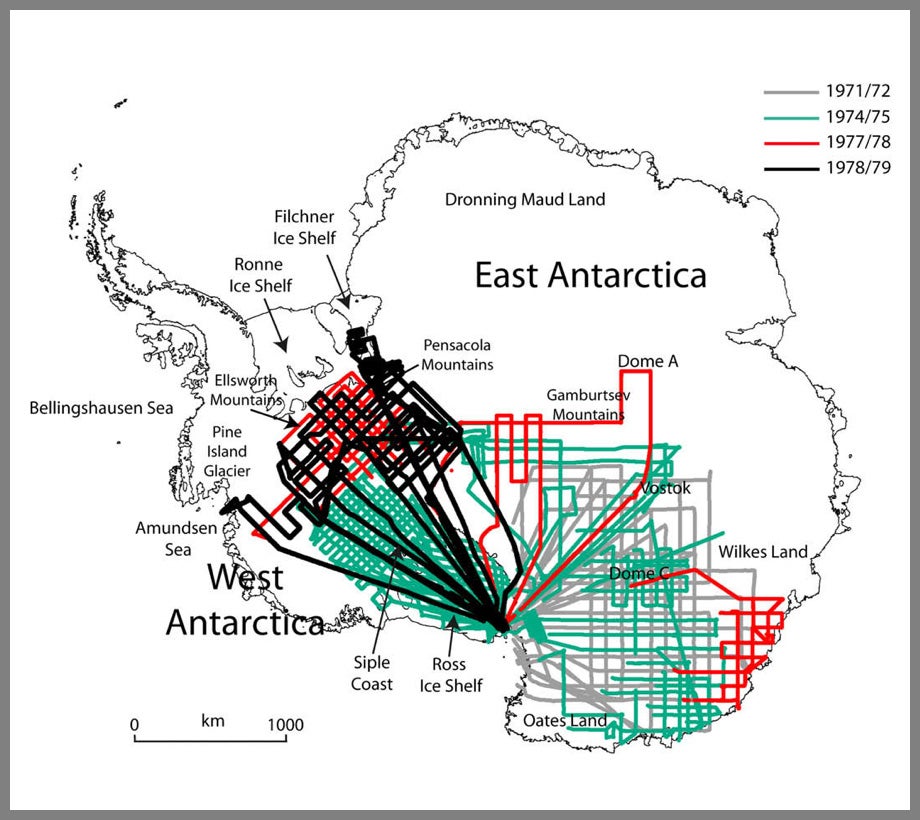
Flight maps of Antarctic radar surveys conducted in the late 1960s and 1970s by an international consortium of scientists. (Image credit: Courtesy Rob Bingham)
Because digital hard drives did not exist back then, scientists recorded the radar data on analog film, which had to then be developed and painstakingly analyzed by hand. “They would shine a light through the film to see the squiggles and images recorded onto the analog record of the film itself, or they’d have to make prints of the film in order to study them,” Schroeder says.
In the intervening years, digital film scanners have been developed that can pluck out new details from old film. “We’re able to now see in the scanned images much fainter features than are discernable to the human eye,” Schroeder says.
Schroeder isn’t the first to have the idea of running old scientific film through modern scanners in order to wring out every last bit of useful data. A project at Lawrence Livermore National Laboratory involves restoring and digitizing old films of atomic bomb tests to improve modern computer models of nuclear detonations.
Lasergraphics, a film scanner company based in Irvine, California, provided the scanners used in both the Livermore and Antarctic projects. The particular model Schroeder used cost roughly $100,000 and can scan film at up to 30 frames per second at 5K resolution.
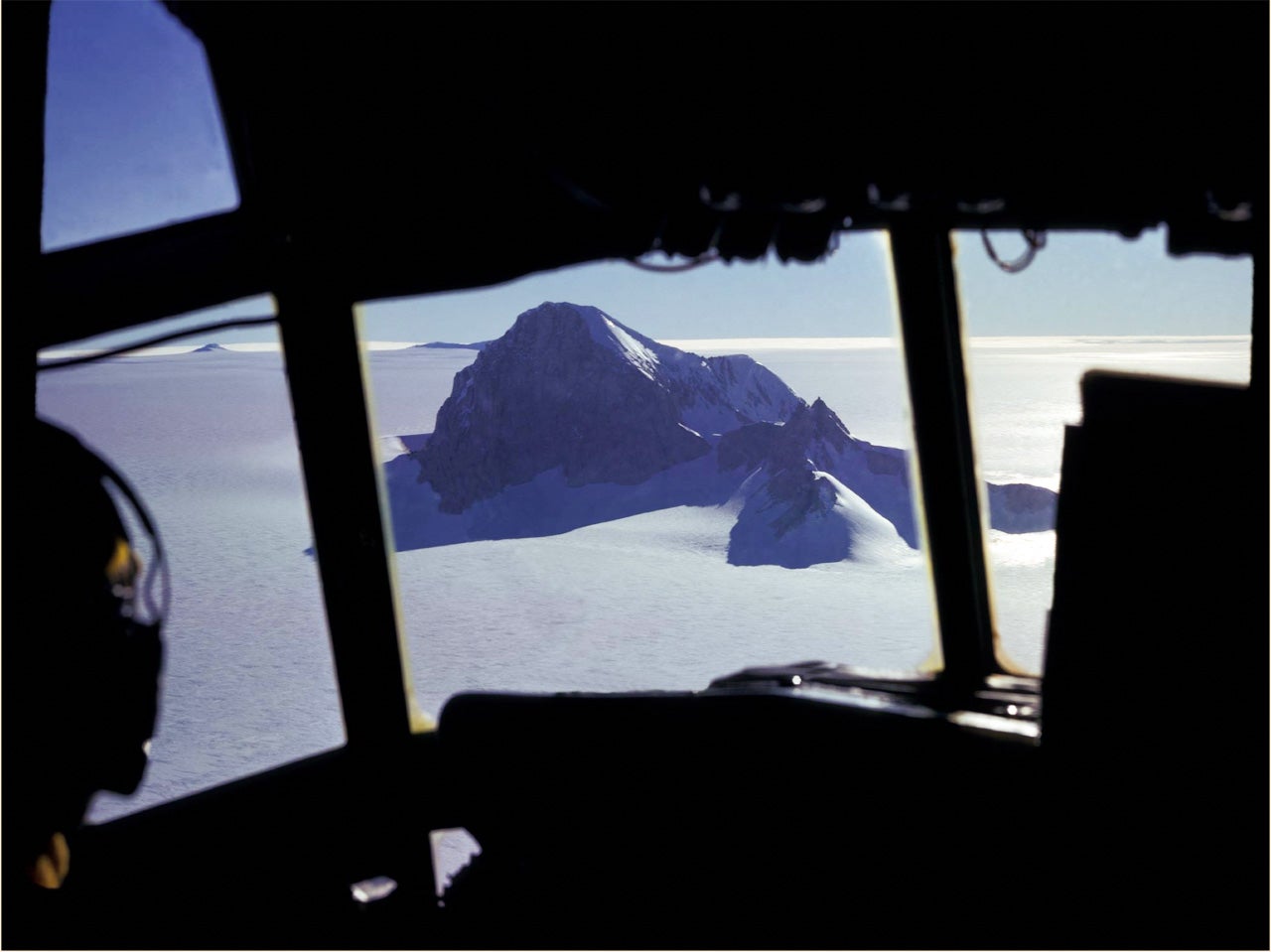
View of Whitmore Mountain in central West Antarctica from the C-130 flight deck. Mountain peaks provided valuable fixed points for navigation as well as regions for scientific investigation. (Image credit: Courtesy David Drewry)
A visit to Cambridge
Before the vintage films could be analyzed, Stanford and SPRI researchers had to catalog, preserve and prepare them into a format the digital scanner could handle.

Gordon Robin (left) and Stan Evans discussing flights at Williams Field in Antarctica’s McMurdo Sound in January 1970. (Image credit: Courtesy David Drewry)
The approximately 1,000 rolls of Antarctic film were stored in a museum in the UK, and Schroeder had permission from SPRI director Julian Dowdeswell to access them. “I knew Dusty from when we were part of a collaborative airborne radar program a few years ago, so I was happy to work with him, given his detailed expertise in the analysis and interpretation of radar data,” Dowdeswell says.
The films’ fragility, however, and the fact that they were also important historical artifacts of polar exploration, meant they could not leave the museum. In order to digitize the film, Schroeder and his scanner – which required two people to carry – had to travel to Cambridge.
With the aid of two art historians he hired for the project, Schroeder spent two weeks at the University of Cambridge meticulously cataloging and then splicing hundreds of rolls of film into approximately 75 reels that the digital scanner could read. “We were in the museum for 14 to 16 hours a day. We were hosted at Cambridge University and ate in the faculty dining hall,” Schroeder says. “It was a very Harry Potter-like experience.”
All told, the Antarctic radar measurements stored on the film took up 80 terabytes’ worth of data, which Schroeder transported back to Stanford on 12 hard drives for analysis.
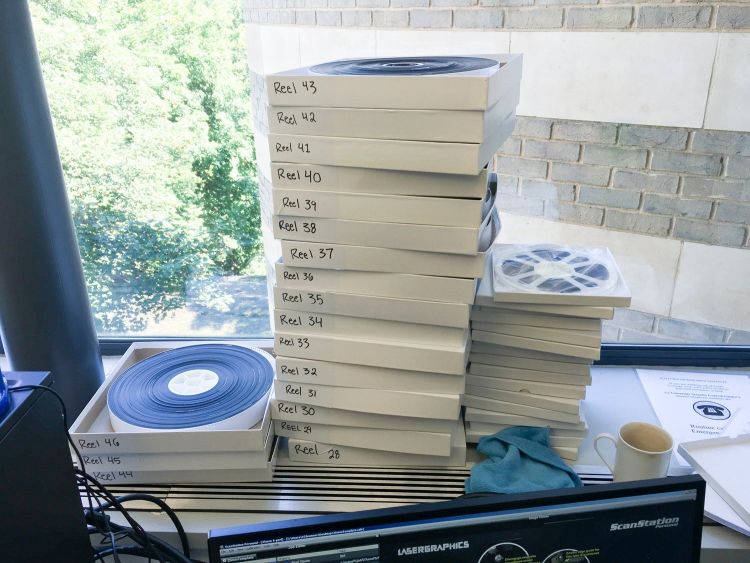
Hundreds of rolls of vintage film had to be condensed into 75 reels before they could be digitally scanned. (Image credit: Dustin Schroeder)

The radar measurements encoded in the films took up about 80 terabytes of data, which were stored onto 12 hard drives and transported back to Stanford for analysis. (Image credit: Dustin Schroeder)
Thank you to the Academy
There was one final hurdle to overcome before Schroeder felt the scanning was complete: In addition to the hundreds of rolls of developed film, there were about 70 cartridges of undeveloped 8mm film.
“The 8mm film contained radiometric information that was absent from the 35mm film,” Schroeder says. “Making use of that information was one of the things I was most excited about on the project.”
But despite all his efforts, Schroeder couldn’t find a place in the UK that still developed the old film format. With his time at Cambridge winding down, Schroeder almost gave up, but then he had an idea.
“I went to Oscars.com, because I figured they know about film,” he says. “That led me to the Academy of Motion Picture Arts and Sciences, and remarkably they were able to put me in touch with some film developers in California. So, I would like to thank the Academy for that.”
Schroeder was allowed to transport the unexposed 8mm film to California for developing, but on one condition: He had to hand carry it and never let it out of his sight. That stipulation led to a tense exchange at Heathrow Airport when Schroeder refused to let security X-ray the film. “I was there holding on to the film, and telling them ‘This is a priceless climate record! Are you comfortable destroying it?’” Schroeder says. “Eventually we came to an understanding and I managed to catch the plane.”
The film was eventually shipped to Pro8mm, a film processing company located just two miles from the Warner Bros. Studio in Burbank, California. Although the company cautioned Schroeder to not get his hopes up with such old film, they were able to digitize everything in a day.

Professor Dustin Schroeder (foreground) and art historian Jessica Daniel splice 50-year-old film containing radar measurements of Antarctica into a reel in preparation for digital scanning at the Scott Polar Research Institute in the UK. (Image credit: Courtesy Dustin Schroeder)
A fresh perspective
To make sense of the newly digitized radar data, Schroeder collaborated with Stanford computer scientists who applied computer vision and machine learning techniques to automatically read and record key numbers on the scanned film images.
The numbers represented information about the configuration of the radar antennas and time stamps of the flights that, when paired with the scientists’ handwritten logs, yielded valuable latitude and longitude information. “To do anything useful with the data, we had to extract all of the printed digits on the film,” says John Emmons, a computer science doctoral student at Stanford who worked on the project.
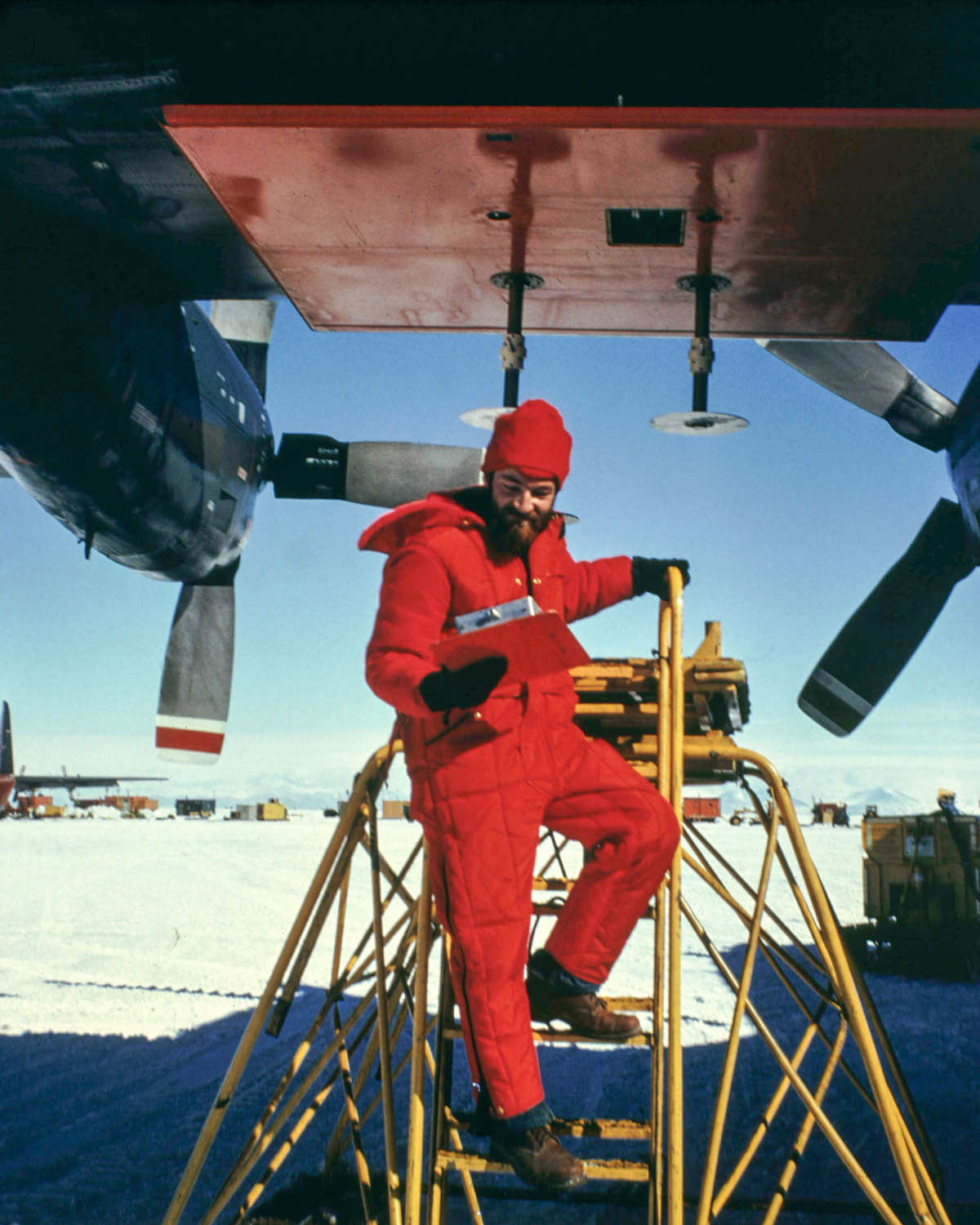
Nils Sko undertaking maintenance on a 300MHz radar antenna on a C-130 plane at McMurdo Sound in Antarctica. (Image credit: Courtesy David Drewry)
Emmons developed a program to read or guess what number a digit represents, even when the digit was on film that had been flipped upside down, or reversed, or partially obscured by adhesive tape.
Keith Winstein, an assistant professor of computer science at Stanford and Emmons’ advisor, says he was excited to work on such an unusual project. “The opportunity to use big data analysis and computer vision techniques to make a contribution to glaciology – that’s a rare and thrilling thing for us,” Winstein says.
Schroeder says the results from his team’s preliminary analyses of the processed data look promising. “Our images show ice layers that were not visible in the older publications because the resolution of the scanned film is so much higher,” Schroeder says.
It’s not only that scientists can now see more in the old films, they are also looking at them with a fresh perspective – one that benefits from half a century’s worth of scientific hindsight. “These data were collected during a time when not much was known about the Antarctic ice sheet,” Schroeder says. “Since then, scientists have found channels beneath the ice shelves and we know more about how grounding lines work. We understand that Antarctica is a much more dynamic place than we thought at the time. When we look at this film now, we can see evidence of a lot of these things in the old records because we know what to look for.”
Schroeder’s group expects to publish results from their project next year and they are working with Stanford Libraries to make the data publicly available through an online virtual exhibition.
Increasingly, Schroeder says his gamble on the high-end film scanner is looking like a smart bet. “We’ve since learned of other similar airborne ice-penetrating surveys of Antarctica and Greenland that were also recorded on film and we’re working toward digitizing them as well,” he says. “The scanner has been a much more interesting and long-lived investment than I thought it was going to be.”
Schroeder is also a faculty affiliate at the Stanford Woods Institute for the Environment and an assistant professor, by courtesy, of electrical engineering at Stanford.
Media Contacts
Dustin Schroeder, School of Earth, Energy & Environmental Sciences: (650) 725-7861, Dustin.M.Schroeder@stanford.edu
Ker Than, School of Earth, Energy & Environmental Sciences: (650) 723-9820, kerthan@stanford.edu